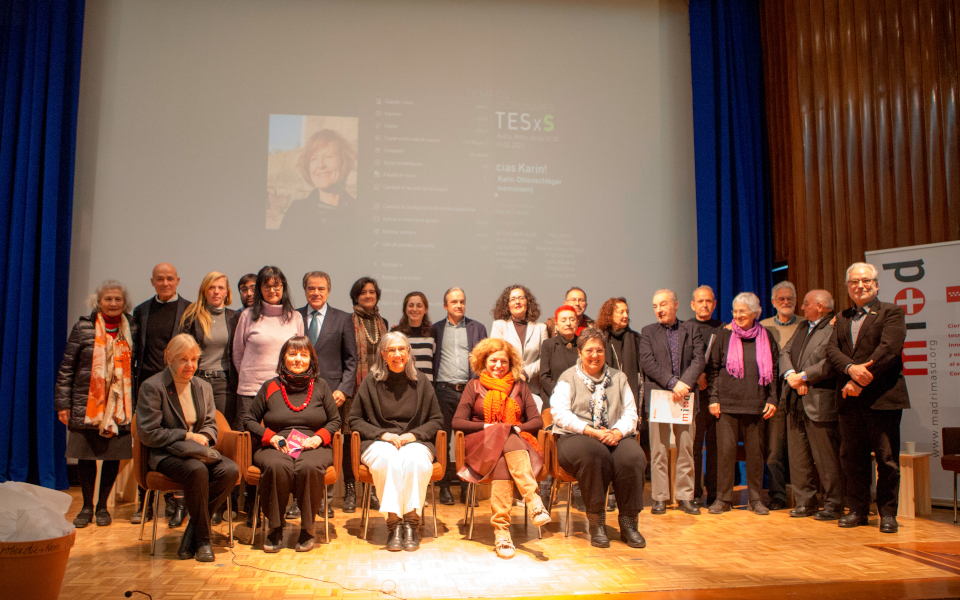
THE MEETING “Transdisciplinary challenges: a tribute to Lynn Margulis and Karin Ohlenschläger”.
February 11 is the International Day of Women and Girls in Science.
On the eve of this great date set by the United Nations, the MEETING “Transdisciplinary Challenges: Tribute to Lynn Margulis and Karin Ohlenschläger” will take place, an inspiring activity organized by Metabolik Planet Program, supported by the Fundación para el Conocimiento Madri+d and the Universidad Complutense, with the aim of contributing to the promotion of women’s vocation in science by giving visibility to the work of innovative women researchers, experts in emerging inter- and transdisciplinary fields (ACTESxS and STEAM).
THE MEETING took place on February 10 at the Faculty of Fine Arts of the Complutense University of Madrid.

I had the honor and pleasure to participate in the panel “Transdisciplinary Challenges ACTESxS” in Module 2 alongside great women, moderator Maria Salazar-Roa, Tere Badia, Nazareth Castellanos, Elisa Martin, Daniela Pavlova, Eva Torremocha.

In the presentation, I made a journey through my professional career in free technology, from the late 90s until today, through the hacker movement, the technological cooperativism in Dabne, the world of start-ups in Berlin, the implementation of the Weesuwul project in Senegal and where I also launched Niit Tekna Logic, as a space for training and promotion of a critical vision of technology, at the crossroads of culture and social entrepreneurship.
After our panel, we had the pleasure of learning a little more about Lynn Margulis through the panel “The Transdisciplinary Legacy of Lynn Margulis” with Carlos Briones, Dorion Sagan, Ricard Guerrero, Mónica Solé, Ricardo Amils,Stephan Harding, Mercè Piqueras and Juli Peretó.

Lynn Margulis(1938-2011) found the solution to a riddle: eukaryotic cells (cells with nuclei found in protozoa, animals, plants and fungi) arose as a result of symbiosis with other simpler cells without nuclei (prokaryotes, i.e. bacteria and archaea). He thus showed that there is not only a gradual evolution (Darwin’s theory of natural selection), but also that certain abrupt and punctual events in the history of life lead to great evolutionary leaps. In doing so, Margulis extended Darwin’s theory of evolution with a fundamental contribution. On: symbiosis allows life to make evolutionary leaps. His theory, which he presented in 1967 (at the age of twenty-nine) was demonstrated in the late 1970s and is widely accepted by the scientific community, but still little known to society at large. Symbiosis as an evolutionary force is a novel concept, it changes the way we see the world.
When the English atmospheric chemist and environmentalist James Lovelock formulated the Gaia hypothesis in 1969, Margulis supported it and sought to extend it, bringing his view that bacteria are primarily responsible for chemical transformations in the biosphere. The Gaia hypothesis highlights the self-regulating capacity of the Earth’s surface, very different from that of a planet similar in size and relative position to the Sun, but devoid of life. The Gaia hypothesis postulates that the conditions of the Earth have been modified by life itself, as part of a continuous co-regulation of the Earth’s surface. The Gaia hypothesis postulates that the conditions of the Earth have been modified by life itself, in a continuous co-evolution between the biosphere and the planet.

Afterwards, a tribute was paid to Karin Ohlenschläger (1959-2022) was an innovative and influential cultural manager, critic and curator specializing in contemporary art and new technologies.
She was also a curator specialized in contemporary art and new technologies. She was born in Hanover (Germany) and came to Spain in the 1980s to embark on a sailing boat and reach the other side of the Atlantic. When she reached the coast of the Canary Islands, she realized that sailing was not her thing. He ended up settling in Madrid and linked up with the art scene through Espacio P, with Pedro Garhel, helping to promote the dialogue between the plastic, visual, scenic and sound arts with programs related to performance, photography, installations, visual poetry, mail art, art and music.
The artist’s return was celebrated by the European Commission and the Council of Europe on the occasion of the opening of the exhibition. at a time when most galleries and museums were celebrating the return of painting.
Karin was a passionate researcher of the transformative potential of the art-life pair. She was interested in exploring the connections between the collaborative, interdisciplinary and self-managed dynamics of art practices of the 1980s and scientific concepts such as metabolism and symbiosis (Lynn Margulis), autopoiesis/self-organization (Humberto Maturana); complex thinking (Edgar Morin); the systemic/holistic approach (Frtijof Capra); dissipative structures (Ilya Prigogine) or the network society (Manuel Castells), among others. All these elements contributed to generate the creative atmosphere and the dynamics of transdisciplinary co-creation and collective intelligence that characterized the Madrid Medialab.